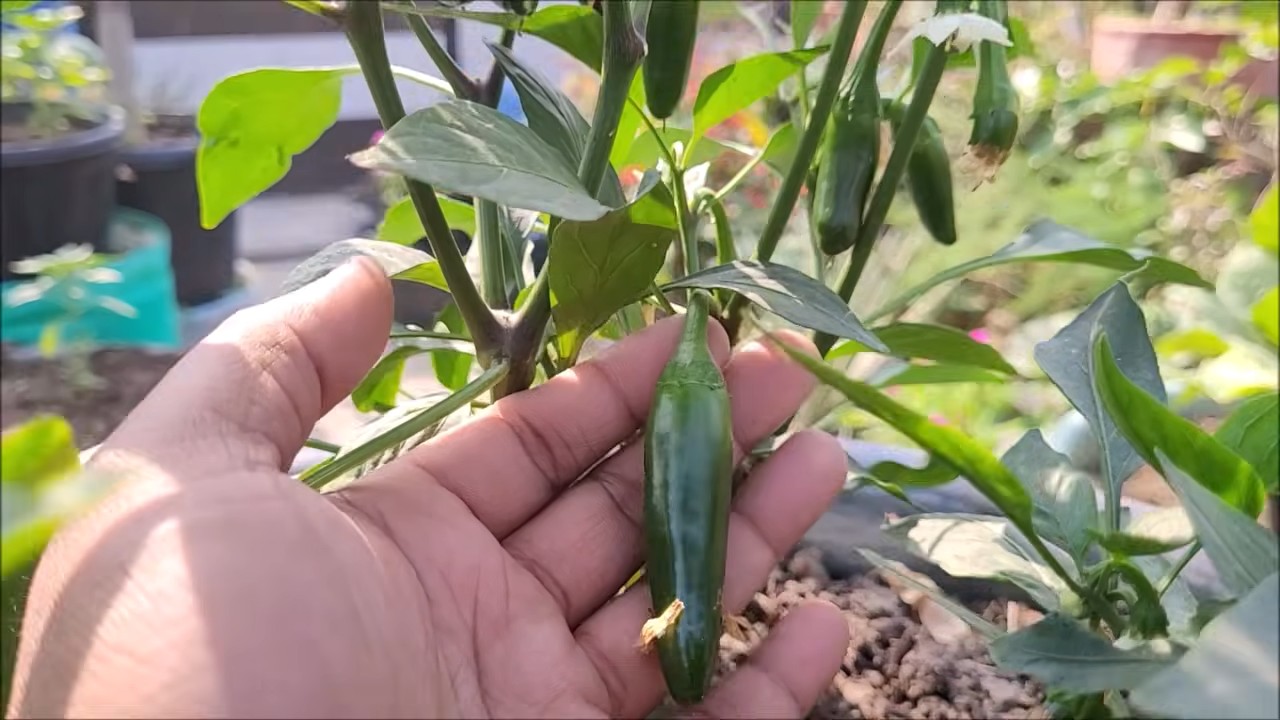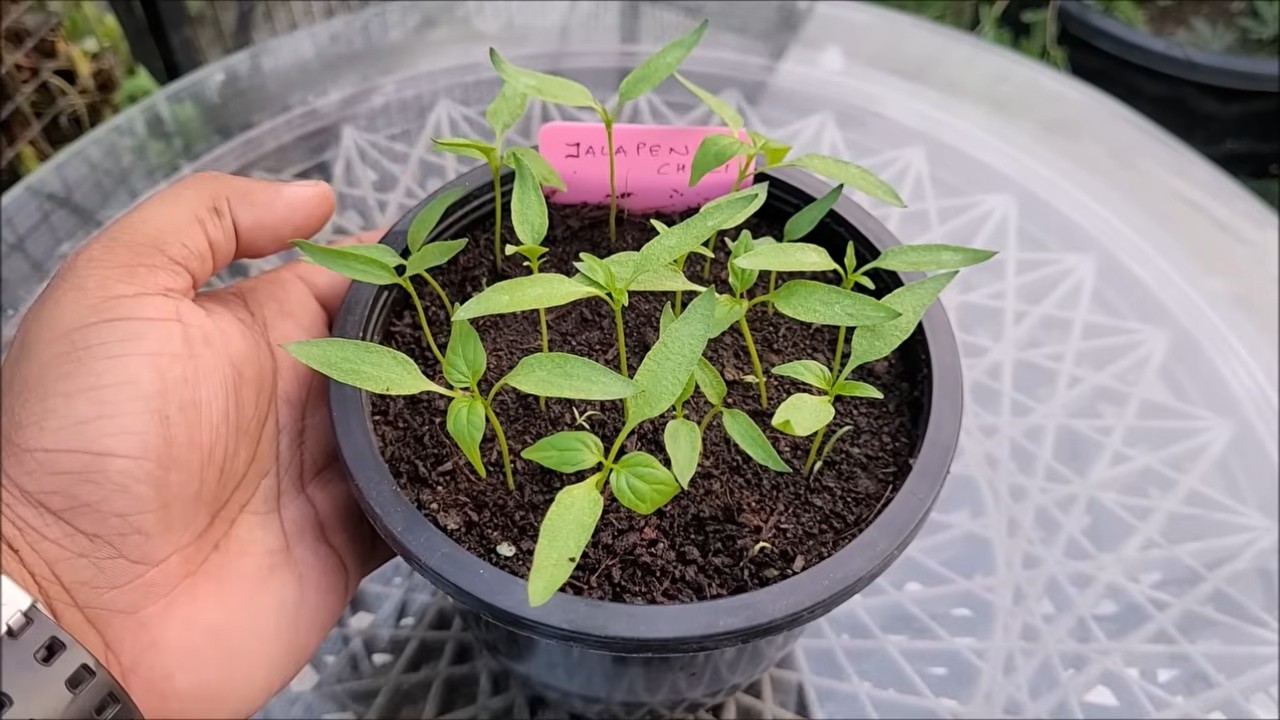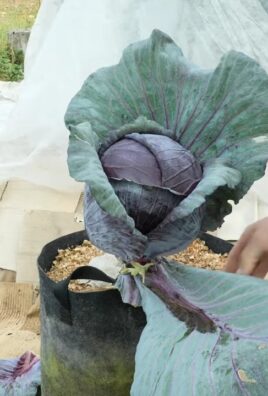Grow Jalapenos from Seed and ignite your culinary adventures! Have you ever dreamt of adding a fiery kick to your homemade salsa or a smoky depth to your chili, all thanks to peppers you nurtured from tiny seeds? Well, stop dreaming and start doing! This DIY guide is your passport to a bountiful harvest of these spicy delights, right in your own backyard (or even on your sunny windowsill!).
The history of jalapenos is as vibrant as their flavor. Originating in Mexico, these peppers have been a staple in Mesoamerican cuisine for centuries. From ancient Aztec dishes to modern-day tacos, jalapenos have added a touch of heat and complexity to countless meals. Imagine connecting with that rich culinary heritage by cultivating your own jalapenos!
Why should you embark on this DIY journey? Because store-bought jalapenos simply can’t compare to the satisfaction of harvesting your own. Plus, you’ll have complete control over the growing process, ensuring your peppers are organic, pesticide-free, and bursting with flavor. More importantly, learning to grow jalapenos from seed is a rewarding experience that connects you with nature and empowers you to become a more self-sufficient gardener. So, grab your gardening gloves, and let’s get started!

Jalapenos aus Samen ziehen: Dein DIY-Guide für eine scharfe Ernte!
Hey Leute! Ich liebe Jalapenos. Ob in Salsa, auf Nachos oder einfach so – die kleinen Schoten bringen ordentlich Feuer ins Essen. Und was gibt es Besseres, als seine eigenen Jalapenos anzubauen? Es ist einfacher, als du denkst! In diesem Guide zeige ich dir Schritt für Schritt, wie du deine eigenen Jalapenos aus Samen ziehst und dich auf eine reiche Ernte freuen kannst. Los geht’s!
Was du brauchst: Die Zutaten für deinen Jalapeno-Erfolg
Bevor wir loslegen, hier eine Liste mit allem, was du brauchst:
* Jalapeno-Samen: Du kannst sie online, im Gartencenter oder sogar aus einer reifen Jalapeno gewinnen (dazu später mehr!).
* Anzuchterde: Normale Blumenerde ist zu nährstoffreich für junge Keimlinge. Anzuchterde ist locker und bietet die perfekte Grundlage.
* Anzuchtgefäße: Kleine Töpfe, Anzuchtschalen oder sogar Eierkartons funktionieren super. Hauptsache, sie haben Drainagelöcher.
* Mini-Gewächshaus oder Frischhaltefolie: Um die Luftfeuchtigkeit hoch zu halten und die Keimung zu beschleunigen.
* Sprühflasche: Zum sanften Befeuchten der Erde.
* Pflanzlampe (optional): Wenn du früh im Jahr startest oder wenig Sonnenlicht hast.
* Etiketten und Stift: Damit du den Überblick behältst, was wo wächst.
* Geduld: Die Natur braucht ihre Zeit!
Phase 1: Die Vorbereitung – Der Grundstein für deine Jalapeno-Pflanzen
1. Samen gewinnen (optional): Wenn du Samen aus einer Jalapeno gewinnen möchtest, wähle eine reife, rote Schote. Schneide sie auf und kratze die Samen heraus. Lasse sie ein paar Tage auf einem Papiertuch trocknen, bevor du sie verwendest.
2. Anzuchtgefäße vorbereiten: Fülle deine Anzuchtgefäße mit Anzuchterde. Drücke die Erde leicht an, aber nicht zu fest.
3. Samen säen: Lege 2-3 Samen pro Gefäß auf die Erde. Bedecke sie mit einer dünnen Schicht Anzuchterde (ca. 0,5 cm).
4. Bewässern: Befeuchte die Erde vorsichtig mit der Sprühflasche. Sie sollte feucht, aber nicht nass sein.
5. Mini-Gewächshaus bauen: Stelle die Anzuchtgefäße in ein Mini-Gewächshaus oder bedecke sie mit Frischhaltefolie. Das sorgt für eine hohe Luftfeuchtigkeit, die die Keimung fördert.
6. Standort wählen: Stelle das Mini-Gewächshaus an einen warmen, hellen Ort. Eine Temperatur von 22-28°C ist ideal. Wenn du wenig Sonnenlicht hast, verwende eine Pflanzlampe.
7. Geduld haben: Jetzt heißt es warten! Die Keimung dauert in der Regel 7-14 Tage. Halte die Erde feucht und lüfte das Mini-Gewächshaus regelmäßig, um Schimmelbildung zu vermeiden.
Phase 2: Die Aufzucht – Vom Keimling zur Jungpflanze
1. Keimlinge beobachten: Sobald die ersten Keimlinge aus der Erde spitzen, kannst du die Frischhaltefolie oder das Mini-Gewächshaus entfernen.
2. Gießen: Gieße die Keimlinge regelmäßig, aber vermeide Staunässe. Die Erde sollte immer leicht feucht sein.
3. Licht: Sorge für ausreichend Licht. Wenn die Keimlinge lang und dünn werden, bekommen sie nicht genug Licht. Eine Pflanzlampe kann hier Abhilfe schaffen.
4. Pikieren (optional): Wenn du mehrere Samen pro Gefäß gesät hast, musst du die Keimlinge pikieren, sobald sie 2-3 echte Blätter haben. Das bedeutet, dass du die schwächeren Keimlinge entfernst und die stärksten in separate Töpfe umpflanzt.
* So geht’s: Befeuchte die Erde in den Töpfen, in die du die Keimlinge umpflanzen möchtest. Löse die Keimlinge vorsichtig mit einem Pikierstab oder einem Löffel aus der Erde. Achte darauf, die Wurzeln nicht zu beschädigen. Setze die Keimlinge in die neuen Töpfe und fülle sie mit Erde auf. Drücke die Erde leicht an und gieße die Keimlinge an.
5. Düngen (optional): Nach 2-3 Wochen kannst du die Jungpflanzen mit einem milden Flüssigdünger düngen. Achte darauf, die Dosierungsanleitung zu befolgen.
Phase 3: Die Auspflanzung – Ab ins Freie!
1. Abhärten: Bevor du die Jungpflanzen ins Freie pflanzt, musst du sie abhärten. Das bedeutet, dass du sie langsam an die Bedingungen im Freien gewöhnst. Stelle sie dazu tagsüber für ein paar Stunden ins Freie und hole sie abends wieder rein. Steigere die Zeit im Freien jeden Tag, bis die Pflanzen den ganzen Tag draußen bleiben können.
2. Zeitpunkt wählen: Pflanze die Jalapenos erst ins Freie, wenn keine Frostgefahr mehr besteht. In der Regel ist das Mitte Mai der Fall.
3. Standort vorbereiten: Wähle einen sonnigen Standort mit gut durchlässigem Boden. Jalapenos lieben Wärme und Sonne! Bereite den Boden vor, indem du ihn lockerst und mit Kompost anreicherst.
4. Pflanzen: Grabe ein Loch, das groß genug ist, um den Wurzelballen der Jungpflanze aufzunehmen. Setze die Pflanze in das Loch und fülle es mit Erde auf. Drücke die Erde leicht an und gieße die Pflanze an.
5. Abstand halten: Pflanze die Jalapenos in einem Abstand von ca. 45-60 cm zueinander.
6. Gießen: Gieße die Jalapenos regelmäßig, besonders bei trockenem Wetter.
7. Düngen: Dünge die Jalapenos alle 2-3 Wochen mit einem Gemüsedünger.
8. Stützen (optional): Wenn die Pflanzen größer werden und viele Früchte tragen, kann es sinnvoll sein, sie zu stützen, damit sie nicht umknicken.
Phase 4: Die Pflege – Damit deine Jalapenos prächtig gedeihen
1. Gießen: Jalapenos brauchen regelmäßig Wasser, besonders während der Fruchtbildung. Achte darauf, dass die Erde immer leicht feucht ist, aber vermeide Staunässe.
2. Düngen: Dünge die Pflanzen alle 2-3 Wochen mit einem Gemüsedünger.
3. Unkraut jäten: Halte den Bereich um die Pflanzen herum unkrautfrei. Unkraut konkurriert mit den Jalapenos um Nährstoffe und Wasser.
4. Schädlinge und Krankheiten: Achte auf Schädlinge wie Blattläuse oder Spinnmilben. Bei Bedarf kannst du biologische Schädlingsbekämpfungsmittel einsetzen. Auch Pilzkrankheiten können auftreten, besonders bei feuchtem Wetter. Sorge für eine gute Belüftung und entferne befallene Blätter.
5. Ausgeizen (optional): Einige Gärtner entfernen die Seitentriebe (Geiztriebe) der Jalapeno-Pflanzen, um die Fruchtbildung zu fördern. Das ist aber nicht unbedingt notwendig.
Phase 5: Die Ernte – Der Lohn deiner Mühe!
1. Erntezeitpunkt: Jalapenos sind erntereif, wenn sie eine schöne grüne Farbe haben und fest sind. Du kannst sie aber auch rot werden lassen, dann sind sie etwas süßer.
2. Ernten: Schneide die Jalapenos mit einem scharfen Messer oder einer Schere ab. Achte darauf, die Pflanze nicht zu beschädigen.
3. Lagerung: Frische Jalapenos halten sich im Kühlschrank etwa eine Woche. Du kannst sie auch einfrieren oder einlegen.
Extra-Tipps für eine extra-scharfe Ernte!
* Sorte wählen: Es gibt verschiedene Jalapeno-Sorten mit unterschiedlichem Schärfegrad. Informiere dich vor dem Kauf, welche Sorte dir am besten schmeckt.
* Stress erhöht die Sch

Conclusion
So, there you have it! Growing jalapenos from seed isn’t just a gardening project; it’s a gateway to a world of flavor, freshness, and the immense satisfaction of nurturing life from a tiny speck. We’ve walked through the entire process, from selecting the right seeds and preparing your growing medium to transplanting your seedlings and providing them with the care they need to thrive.
Why is this DIY trick a must-try? Because it puts you in complete control. You choose the variety of jalapeno you want, ensuring you get the exact level of heat and flavor you crave. You avoid the uncertainties of store-bought produce, knowing exactly what went into growing your peppers – no mystery chemicals or questionable farming practices. Plus, it’s significantly more cost-effective than constantly buying jalapenos at the grocery store, especially if you’re a chili enthusiast who uses them regularly.
But the benefits extend beyond just practicality. There’s a unique connection you forge with your food when you grow it yourself. You witness the miracle of germination, the slow and steady growth of the plant, and the eventual reward of harvesting your own spicy bounty. It’s a deeply rewarding experience that connects you to nature and provides a sense of accomplishment.
Looking for variations? Absolutely! Once you’ve mastered the basics of growing jalapenos from seed, you can experiment with different varieties. Try growing poblano peppers for a milder flavor, or serrano peppers for a significant heat boost. You can also explore different growing methods, such as hydroponics or container gardening, to adapt to your space and preferences. Consider companion planting – basil, tomatoes, and carrots are all excellent companions for jalapenos, helping to deter pests and improve growth. You can even try fermenting your harvested jalapenos to create your own homemade hot sauce or pickled peppers – the possibilities are endless!
Don’t be intimidated if you’re a beginner. Gardening is a learning process, and even experienced gardeners encounter challenges. The key is to be patient, observant, and willing to learn from your mistakes. Start small, perhaps with just a few plants, and gradually expand your garden as you gain confidence.
We wholeheartedly encourage you to give growing jalapenos from seed a try. It’s a fun, rewarding, and ultimately delicious experience. And we want to hear about your journey! Share your successes, your challenges, and your tips in the comments below. Let’s create a community of jalapeno-growing enthusiasts and learn from each other. Show us your pictures of your seedlings, your flourishing plants, and your bountiful harvests. Let’s celebrate the joy of growing our own food together! So, grab some seeds, get your hands dirty, and prepare to enjoy the fiery flavor of homegrown jalapenos. You won’t regret it! This **grow jalapenos from seed** guide is your first step to a spicier life.
Frequently Asked Questions (FAQ)
1. How long does it take to grow jalapenos from seed?
The time it takes to grow jalapenos from seed to harvest can vary depending on several factors, including the variety of jalapeno, the growing conditions, and the climate. Generally, you can expect it to take anywhere from 60 to 90 days from the time you sow the seeds to the time you can harvest your first peppers.
* **Germination:** Jalapeno seeds typically germinate within 7 to 14 days, provided they are kept warm and moist.
* **Seedling Stage:** After germination, the seedlings will need several weeks to develop into strong, healthy plants. This stage usually lasts for 4 to 6 weeks.
* **Transplanting:** Once the seedlings have developed several sets of true leaves and are large enough to handle, they can be transplanted into larger pots or directly into the garden.
* **Fruiting:** After transplanting, it will take another 6 to 8 weeks for the plants to begin producing flowers and then peppers.
Keep in mind that these are just estimates, and the actual time may vary. Providing optimal growing conditions, such as plenty of sunlight, well-drained soil, and regular watering, can help to speed up the process.
2. What are the best conditions for growing jalapenos from seed?
Jalapenos thrive in warm, sunny conditions with well-drained soil. Here’s a breakdown of the ideal conditions:
* **Sunlight:** Jalapenos need at least 6-8 hours of direct sunlight per day. Choose a location in your garden that receives plenty of sun. If you’re growing them indoors, use grow lights to supplement natural sunlight.
* **Soil:** Jalapenos prefer well-drained soil that is rich in organic matter. Amend your soil with compost or other organic materials to improve drainage and fertility. A slightly acidic to neutral pH (around 6.0 to 7.0) is ideal.
* **Temperature:** Jalapenos are warm-weather plants and prefer temperatures between 70°F and 85°F (21°C and 29°C). They are sensitive to frost, so be sure to protect them from cold temperatures.
* **Watering:** Water jalapenos regularly, especially during hot, dry weather. Avoid overwatering, as this can lead to root rot. Allow the soil to dry out slightly between waterings.
* **Fertilizing:** Feed your jalapeno plants with a balanced fertilizer every few weeks during the growing season. Look for a fertilizer that is specifically formulated for vegetables or peppers.
3. How often should I water my jalapeno plants?
The frequency of watering jalapeno plants depends on several factors, including the climate, the type of soil, and the size of the plant. As a general rule, you should water your jalapeno plants when the top inch of soil feels dry to the touch.
* **Check the Soil:** The best way to determine if your jalapeno plants need water is to check the soil moisture. Stick your finger into the soil about an inch deep. If the soil feels dry, it’s time to water.
* **Water Deeply:** When you water your jalapeno plants, water deeply so that the water reaches the roots. This will encourage the roots to grow deeper and make the plants more drought-tolerant.
* **Avoid Overwatering:** Overwatering can lead to root rot, which can kill your jalapeno plants. Be sure to allow the soil to dry out slightly between waterings.
* **Consider the Weather:** During hot, dry weather, you may need to water your jalapeno plants more frequently. During cool, wet weather, you may need to water them less frequently.
* **Use Mulch:** Applying a layer of mulch around your jalapeno plants can help to retain moisture in the soil and reduce the need for watering.
4. What are common problems when growing jalapenos from seed, and how can I fix them?
Growing jalapenos from seed can be a rewarding experience, but it’s not without its challenges. Here are some common problems and how to address them:
* **Poor Germination:** If your jalapeno seeds aren’t germinating, it could be due to several factors, including old seeds, cold temperatures, or improper moisture levels. Use fresh seeds, keep them warm (around 75-85°F), and ensure the soil is consistently moist but not waterlogged.
* **Seedling Damping Off:** This fungal disease can cause seedlings to rot at the soil line and collapse. Prevent damping off by using sterile potting mix, providing good air circulation, and avoiding overwatering. If you see signs of damping off, remove the affected seedlings immediately.
* **Aphids:** These small, sap-sucking insects can infest jalapeno plants and weaken them. Control aphids by spraying them with a strong stream of water, using insecticidal soap, or introducing beneficial insects like ladybugs.
* **Blossom End Rot:** This condition causes the bottom of the jalapenos to rot. It’s usually caused by a calcium deficiency in the soil. Prevent blossom end rot by adding calcium to the soil before planting and ensuring consistent watering.
* **Lack of Fruit Production:** If your jalapeno plants are not producing fruit, it could be due to a lack of pollination, insufficient sunlight, or nutrient deficiencies. Hand-pollinate the flowers, ensure the plants are getting at least 6-8 hours of sunlight per day, and fertilize them with a balanced fertilizer.
* **Pests and Diseases:** Keep an eye out for other pests and diseases, such as spider mites, whiteflies, and fungal infections. Treat any problems promptly with appropriate insecticides or fungicides.
5. Can I grow jalapenos from seed indoors?
Yes, you can absolutely grow jalapenos from seed indoors! In fact, starting your seeds indoors is often recommended, especially in regions with shorter growing seasons. Here’s what you need to know:
* **Starting Seeds Indoors:** Start your jalapeno seeds indoors 6-8 weeks before the last expected frost. Use a seed-starting tray or small pots filled with sterile seed-starting mix.
* **Light:** Jalapeno seedlings need plenty of light to grow strong and healthy. If you don’t have a sunny window, use grow lights to provide supplemental lighting.
* **Temperature:** Keep the seedlings warm, around 70-80°F (21-27°C). Use a heat





Leave a Comment